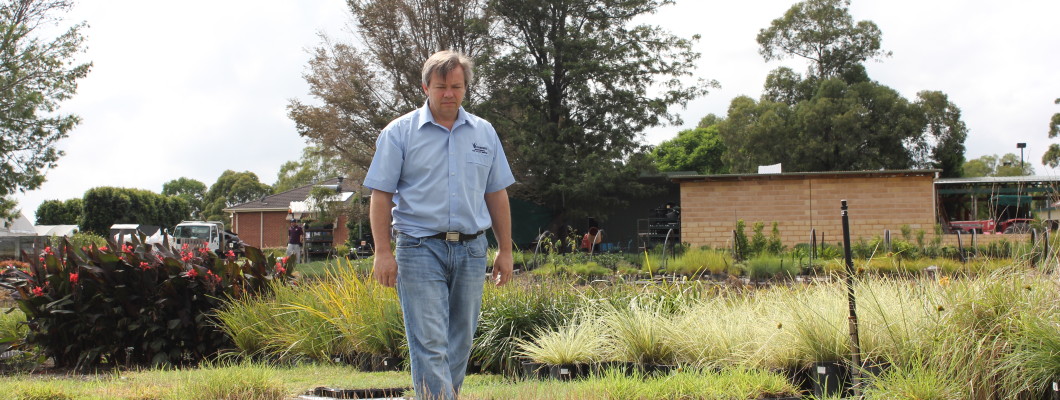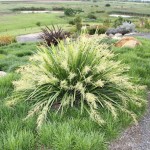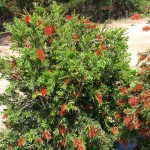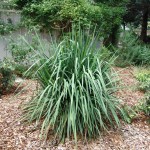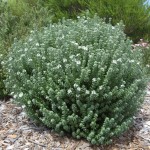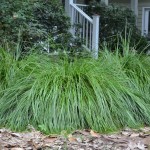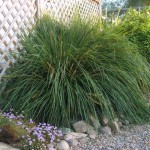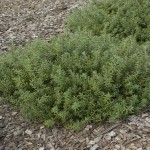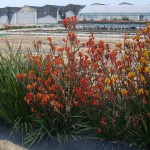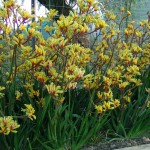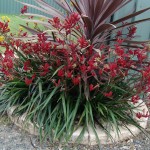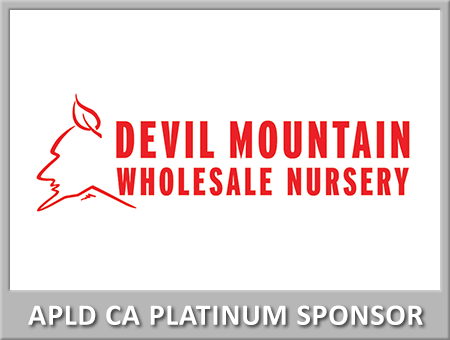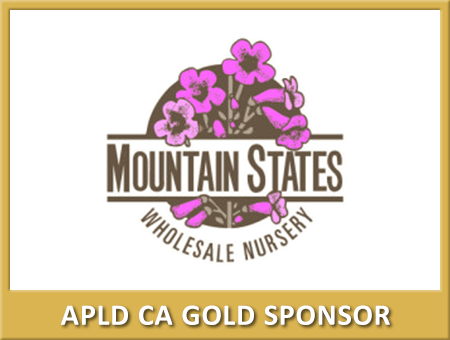Tuffy Plants for the New California Garden
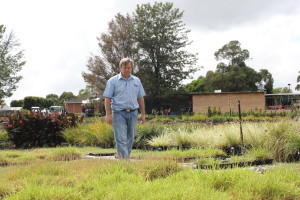
Todd Layt, walking some of his ongoing turf breeding grounds.
All landscape designers are on a timeless search for the perfect supporting players that hold a garden together—no matter what the conditions. The rains had not yet begun when I got a chance last October to talk with Todd Layt, of Ozbreed Pty Ltd in NSW Australia, a plant breeding company and contributor to the Tuffy Plant Collection™, (an APLD CA Gold Sponsor). As you might imagine, our conversation started with the California drought.
—Maureen Decombe, 2009 Past President, APLD California Chapter
Throughout Australia’s drought, you have developed a line of plants that can stand up to extreme conditions. You’ve lived through this and come through to the other side, what can we expect in California?
In Australia, even in the earliest days, water restrictions quickly became the norm. The industry realized that the path to self-preservation was voluntarily shifting production to more drought tolerant plants and then they led the charge to convince people to use drought tolerant plants. Once the drought hit we were ready to go.
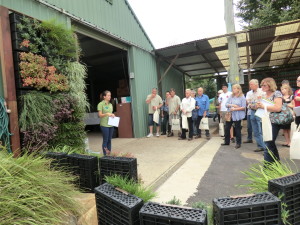
A talk on green walls, led by an Ozbreed staffer.
In California, we expect El Niño to make an appearance, with a chance of drenching rains and significant stormwater runoff. We need plants that work in wet and dry conditions. What is your standby plant for rain collection areas that go dry in summer?
In general, most Tuffy varieties are best suited to drier conditions, but there are some exceptions. If it’s very wet, Lomandra ‘Katie Belles” is particularly good with wet feet. Other varieties that have proven adaptable to periodic wet feet are Callistemon ‘Slim’, Callistemon ‘Macarthur’, Dianella ‘King Alfred’, Lomandra ‘TropicBelle’, and Westringia ‘Grey Box’.
We have a new one coming out soon—in a year—Lomandra ‘Baby Breeze’, a dwarf that is one-half the height of Lomandra ‘Breeze’, but it can handle very wet soils. These same varieties also respond well to accidental overwatering due to irrigation management issues at any time of the year making them better than succulents in cases of overwatering.
And, when these wet areas turn dry, Lomandra and Dianella have a survival mechanism that allows them to regulate their water use in dry weather, which makes them highly adaptable. Normal plant functions (“metabolic processes”) slow down, allowing plants to stay evergreen during long dry spells.
Click on the plant pics below for more details:
If I asked you for a “Top Five” from your collection, based on overall garden worthiness, what might surprise us from that list?
Westringia ‘Grey Box’ won plant of the year in Australia, and it is growing well with wet feet in our trial garden. It is a great rain garden plant, which surprised everyone. Westringia ‘Mundi’ is not quite as good, but can hold its own with short inundation.
What about combining Tuffy Plants with California Native Plantings?
Sam would be a good person to answer this in more detail. Lomandras play nice with wildflowers for a meadow effect. The new Westringias also work well in this application. They are reliable supporting players.
A successful mixed planting is only as good as the weakest plant. Drifts and mass plantings work best, and all do best in groups rather than mixed. Follow the 80/20 rule for plants—use 80% that are tough and work hard, then play with the remaining 20%.

Lomandra ‘Breeze’ in a garden setting
Any concerns about invasiveness under these conditions?
Lomandra is a dioecious species meaning there are separate male and female plants. All of our Lomandra selections are male. So, in the absence of female Lomandra, there will be no reseeding. Even in their native habit, Lomandra has a low seed viability. Of the other four taxa currently in the Tuffy program – Anigozanthos, Callistemon, Dianella, and Westringia – reseeding and invasiveness is not typically a concern.
Establishment and early maintenance of plantings is particularly important for long-term success. What works best for the “Meadow Effect” you mentioned earlier?
Plant from plugs; and plant for weed control, spacing plugs at 4-6 plants per square yard to keep weeds out. A dense plug planting can rapidly shade the soil, offering the weed control of thicker plantings with the affordability and shipping advantages of plugs. These and other advantages have led to wide adaptation in roadside and commercial applications, and this is not just a drought response. We have been planting this way for 40-50 years. A few years back DIG adopted a similar plug program here in the US, which they are now marketing as the SuperTuff landscape plug program.
 Planting an Australian streetscape from plugs |
 A few plants go a long way, spaced 4-6 plants per square yard |
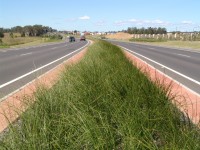 After establishment: weed-free and thick with new growth |
Dry slopes are a big concern to those of us who live in hillsides. With El Niño making an appearance after this dry spell, there are many exposed hillsides. Do you have any words of wisdom?
Any grass or strappy plant has incredible root systems. Grasses have much deeper root systems than shrubs. Research shows significant advantages among the Dianellas. Their roots spread even faster and farther. (For more details on this research, click here.)
About that “Top Five List”…
I look for plants that thrive in Western Australia to perform well in California: Lomandra ‘Breeze’; Dianella ‘Cassa Blue’; and D. ‘Little Rev’, if cut back every 3-4 years; L. ‘Nyalla’ for coastal salt tolerance; and ‘Grey Box’- the pick of the Westringias – as well as W. ‘Low Horizon’, a selection of W. ‘Mundi’, as a ground cover…
Click on the plant pics below for more details:
Wait, that’s more than five…
Callistemons! ‘Green John’ is dark green and 20% smaller. I love a Callistemon next to a wall. ‘Slim’ can be sheared hard in applications where you need a dense screen. (Sam McCoy had some additional “Top Plants” to share. See these at the end of this post.)
With the exception of the Callistemons, you’re referring to mostly ever-green background players. What about a pop of reliable color?
Another favorite—Velvet Kangaroo Paws—do not get blackspot, and are longer lived. They are not annuals, like many on the market. For ease of maintenance, perennial Anigozanthos is a must. The “Velvets” hold their leaves and structure longer, due to the Anigozanthos flavidus in their makeup.
Though they are not fussy about fertilizer, Anigozanthos like to be fertilized, and can tolerate richer soils. Cut back once per year at the end of winter to encourage new growth.
Do you have any more maintenance suggestions?
Most of these plants can tolerate hard pruning any time of year, as long as 4-6” of leaf blade are left behind. And Lomandra ‘Breeze’ can be sheared into a ball. Normally, however, like most of these plants, ‘Breeze’ can be cut back every 5-7 years to look its best, and ‘Casa Blue’ does better with a 5 year haircut. All can grow in deficient soils, but can become more ornamental with nutrients. Compost, mulch, or anything that adds carbon to the soil is beneficial.
Thank you, Todd, it looks like there are some Tuffy Plants in my future!
Tuffy Plants is the premier brand for Sam McCoy’s Dig Plant Co. Thank you, Sam, for setting up this interview. Current APLD Members – be on the lookout for the highly popular Tuffy Plant Giveaway, coming in Fall, 2016.
For a closer look at the Tuffy Plant Collection, visit www.tuffyplants.com

Sam McCoy and Todd Layt looking at Lomandra ‘Katie Belles’ at a nursery in south Florida… wet, wet, wet! But doing great!
Sam McCoy’s Top Plants for Garden Worthiness
I asked Sam McCoy to share some if his Top Plants for Garden Worthiness, based on his experience here and in Australia. Here are some of Sam’s observations and favorites:
My “Top Three” for overall garden worthiness (namely low-water, low-maintenance western gardens) would undoubtedly be Lomandra ‘LM300’ Breeze, Dianella ‘DBB03’ Cassa Blue, and Dianella ‘DR5000’ Little Rev. These three have a more than 10 year track record in the States and more than 15 years in Australia.
Our “Velvet” kangaroo paw varieties have also become quite popular with growers and their customers, but those would not be as drought tolerant was these others. If we’re talking about plants that can run the spectrum from wet to dry, that would be Lomandra ‘LHBYF’ Katie Belles, Dianella ‘JOHN316’ King Alfred, Westringia ‘Grey Box’, and any of the Callistemon selections. Consult with your local nursery for a recommendation of complimentary plants.
And, on the subject of maintenance, Sam had these recommendations:
In general, prune every 4-6 years or as needed. When pruning is required, prune in spring (not late winter like ornamental grasses) to ensure proper regrowth. Fertilize annually in the spring or fall, or as the plants ‘signal’ that they are hungry (i.e. chlorosis, lack of vigor, etc). Water only as needed, once established. For answers to specific questions you should ask your local wholesale nursery, visit the Tuffy website, where you can find landscape spec sheets for each variety, or call DIG Plant Co, where Sam will be happy to help.
(c) 2016, APLD California Chapter

